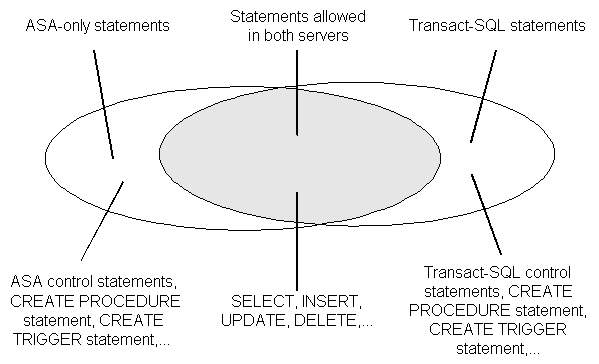







ASA SQL User's Guide
Transact-SQL Compatibility
Adaptive Server Anywhere supports a large subset of Transact-SQL, which is the dialect of SQL supported by Sybase Adaptive Server Enterprise. This chapter describes compatibility of SQL between Adaptive Server Anywhere and Adaptive Server Enterprise.
The goals of Transact-SQL support in Adaptive Server Anywhere are as follows:
Application portability Many applications, stored procedures, and batch files can be written for use with both Adaptive Server Enterprise and Adaptive Server Anywhere databases.
Data portability Adaptive Server Anywhere and Adaptive Server Enterprise databases can exchange and replicate data between each other with minimum effort.
The aim is to write applications to work with both Adaptive Server Enterprise and Adaptive Server Anywhere. Existing Adaptive Server Enterprise applications generally require some changes to run on an Adaptive Server Anywhere database.
Transact-SQL support in Adaptive Server Anywhere takes the following form:
Many SQL statements are compatible between Adaptive Server Anywhere and Adaptive Server Enterprise.
For some statements, particularly in the procedure language used in procedures, triggers, and batches, a separate Transact-SQL statement is supported together with the syntax supported in previous versions of Adaptive Server Anywhere. For these statements, Adaptive Server Anywhere supports two dialects of SQL. In this chapter, we name those dialects Transact-SQL and Watcom-SQL.
A procedure, trigger, or batch is executed in either the Transact-SQL or Watcom-SQL dialect. You must use control statements from one dialect only throughout the batch or procedure. For example, each dialect has different flow control statements.
The following diagram illustrates how the two dialects overlap.

Adaptive Server Anywhere supports a very high percentage of Transact-SQL language elements, functions, and statements for working with existing data. For example, Adaptive Server Anywhere supports all of the numeric functions, all but one of the string functions, all aggregate functions, and all date and time functions. As another example, Adaptive Server Anywhere supports Transact-SQL outer joins (using =* and *= operators) and extended DELETE and UPDATE statements using joins.
Further, Adaptive Server Anywhere supports a very high percentage of the Transact-SQL stored procedure language (CREATE PROCEDURE and CREATE TRIGGER syntax, control statements, and so on) and many, but not all, aspects of Transact-SQL data definition language statements.
There are design differences in the architectural and configuration facilities supported by each product. Device management, user management, and maintenance tasks such as backups tend to be system-specific. Even here, Adaptive Server Anywhere provides Transact-SQL system tables as views, where the tables that are not meaningful in Adaptive Server Anywhere have no rows. Also, Adaptive Server Anywhere provides a set of system procedures for some of the more common administrative tasks.
This chapter looks first at some system-level issues where differences are most noticeable, before discussing data manipulation and data definition language aspects of the dialects where compatibility is high.
Some SQL statements supported by Adaptive Server Anywhere are part of one dialect, but not the other. You cannot mix the two dialects within a procedure, trigger, or batch. For example, Adaptive Server Anywhere supports the following statements, but as part of the Transact-SQL dialect only:
Transact-SQL control statements IF and WHILE
Transact-SQL EXECUTE statement
Transact-SQL CREATE PROCEDURE and CREATE TRIGGER statements
Transact-SQL BEGIN TRANSACTION statement
SQL statements not separated by semicolons are part of a Transact-SQL procedure or batch
Adaptive Server Enterprise does not support the following statements:
control statements CASE, LOOP, and FOR
Adaptive Server Anywhere versions of IF and WHILE
CALL statement
Adaptive Server Anywhere versions of the CREATE PROCEDURE, CREATE FUNCTION, and CREATE TRIGGER statements
SQL statements separated by semicolons
The two dialects cannot be mixed within a procedure, trigger, or batch. This means that:
You can include Transact-SQL-only statements together with statements that are part of both dialects in a batch, procedure, or trigger.
You can include statements not supported by Adaptive Server Enterprise together with statements that are supported by both servers in a batch, procedure, or trigger.
You cannot include Transact-SQL-only statements together with Adaptive Server Anywhere-only statements in a batch, procedure, or trigger.



